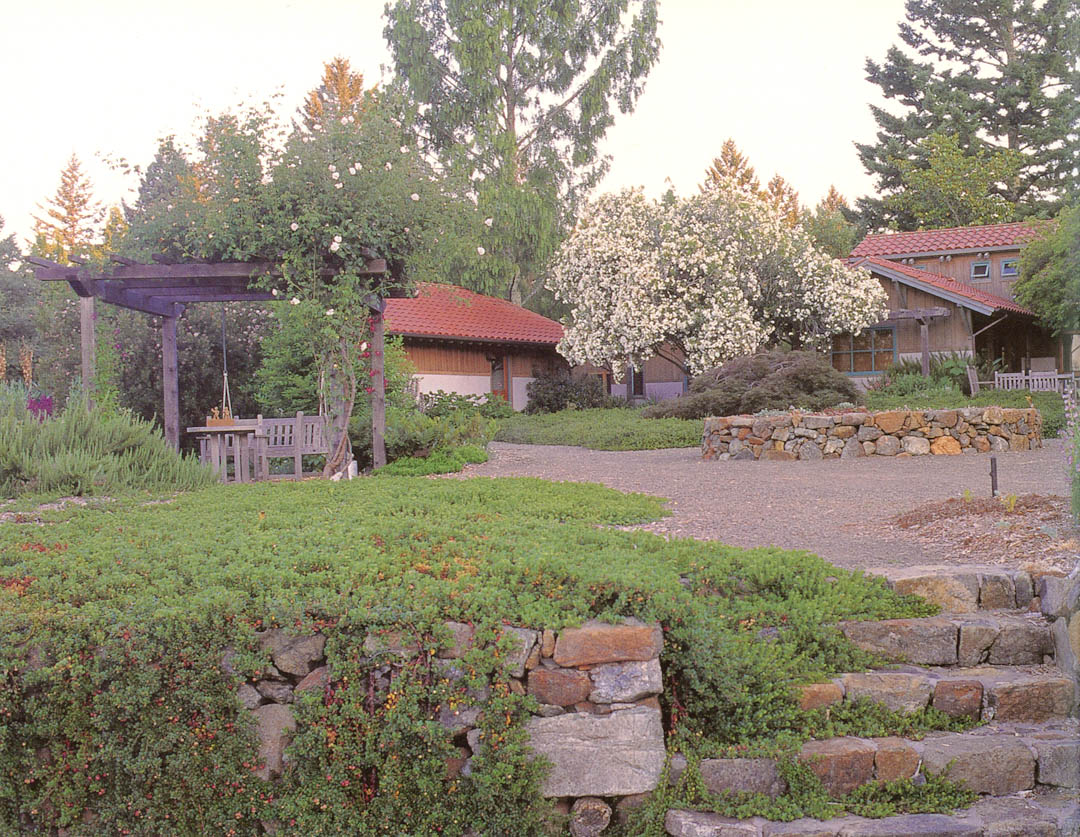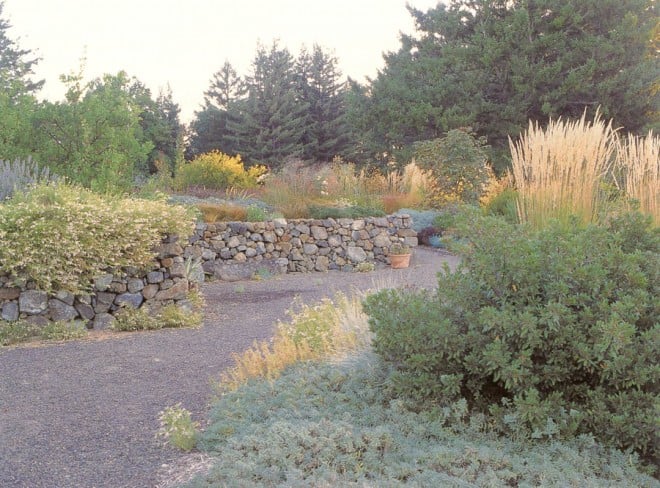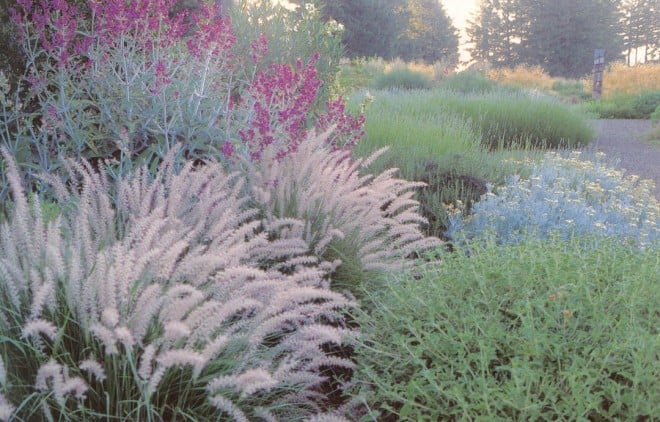
On a Sonoma Hilltop

Contributor
- Topics: Plants You Need, Sustainable Gardening

There is much to be said for living on a hill.
Roger B Swain, Groundwork
The home of Mary and Lew Reid sits atop a hill at the end an unpaved country road that winds for several miles through some of the best of Northern California’s rolling oak woodlands, past ponds and pastures, farms and vineyards. The final curve in the road sweeps beneath a grove of enormous and stately Douglas firs to reveal the first glimpse of their garden. Here, just beyond the quaint town of Occidental in rural western Sonoma County, Lew and Mary have collaborated to create a garden that is so well conceived and designed, so well planted and grown, and so beautifully integrated into the surrounding landscape that it must be considered among the finest gardens in Northern California.

A great work of art has the ability to transform our vision of the world, to help us see things in a new way, and to illuminate a new world of possibilities. An artful garden shares this quality, and we take its lessons forward into our own lives and gardens. The Reid garden is such a garden. It succeeds on several levels, its lessons are many and varied, and each visitor is moved by something perceived—an idea or concept to be carried home, pondered, and perhaps adapted for use elsewhere.
“I think of it as a painting”, says Mary “one that I can change. A garden takes longer than a painting to see what you’ve created, but then the plants offer their own marvelous surprises; things that happen accidentally can be wonderful, and sometimes the best ideas come from those spontaneous, serendipitous moments. This is truly something I do for the love of it. We propagate most of the plants for this garden, which makes the scale of it possible and results in a kind of enforced patience—to propagate the plants and wait for them to grow.”
It is clear, when strolling around this garden, that one of Mary’s talents is the ability to visualize the borders from every perspective. She spends a long time planning with a pencil and graph paper so that she can see how her plant compositions will look from all sides. From virtually any place in the garden, the plantings reach toward one another, their colors and textures uniting in extraordinary combinations. The discipline of this wife and husband team is evident everywhere, in the use of large masses and in the new and exciting plants they play with in the garden. Their garden is a rich tapestry that blends, delights, and amazes.
Adapting to the Country
Their move to this large rural property in 1991 was a major change in lifestyle for this essentially urban couple, and they wanted to go about it carefully, respectfully, and appropriately. The Reids take their role as stewards of this extraordinary place seriously. Land use issues are important to them; Lew has been a board member of the Sonoma Land Trust for many years. Their priorities and concerns began shaping the garden from the first moment. They focussed on giving themselves the garden they wanted without adversely impacting upon the beautiful surroundings, the agricultural character and history of the area, and the magnificent natural plant communities on the property.
To start, the surrounding meadow was cleared of star thistle, a particularly noxious weed throughout much of California. The invasive brooms (both Cytissus and Spartium) are being eliminated, a constant task. Any green waste from the garden is kept essentially within the developed part of the property, meaning that prunings are chipped, composted, and returned to the soil. Lew and Mary are careful not to introduce any potentially invasive plants. Cattle continue to graze in appropriate numbers in the meadows below the garden. The property also includes an area of serpentine soils, which they have deemed off-limits to any development or grazing; the spring wildflowers and western azalea (Rhododendron occidentale) there create a natural garden of unsurpassed beauty.
Research turned up a design for a low-profile deer fence; it consists of two parallel fences four feet high and five feet apart. A more traditional eight-foot fence would have been visually intrusive, blocking the views from the garden and creating an eyesore for miles around. The shorter, double fence has been a complete success. Deer continue to graze in the meadows just outside the garden’s limits.
The garden’s clay soil is continually being improved through the use of manure and mulches. The Reids believe that the soil comes first, whether that means understanding the native soil and selecting plants that will thrive in it, or understanding the soil in order to amend it for the plants one wants to grow. Before anything was planted here, they installed a drip irrigation system; they are gradually changing the system to mist or spray due to the constant need to monitor and maintain a drip system. Their garden has been done sensibly from the beginning: good bones, good soil, good irrigation.

Separate Tasks
Lew’s role is chief propagator and plant collector. Travels to both South Africa and Australia have resulted in new plants for their garden, but he also collects nearby. He recently brought an unusual monardella into cultivation from their serpentine meadow. The task of design falls to Mary, a professional garden designer, and her artistic vision has guided the creation of this two-acre horticultural playland. She followed a system devised by English designer John Brookes to arrange paths, rock walls, and planting beds that became the framework of the garden. “His method is laid out clearly in several of his books, and is very accessible,” she says. “It takes a lot of the mystery out of the process. I don’t think about specific plants until well along in the design.”
The first glimpse of the garden is of a long sweep of Miscanthus sinensis ‘Gracillimus’ that appear as a low colonnade accentuating the curve of the road. The road then plunges into a shady dell, emerging at the front of the house, a beautiful, Maybeck-inspired home nestled beneath large trees such as a dawn redwood (Metasequoia glyptostroboides) and an ancient white oleander (Nerium oleander). The entry garden is a transitional moment, where Mary’s design is just beginning to be revealed. A bed of white-flowered Helleborus orientalis defines one side of the path, opposite several contrasting South African restios (Elegia capensis), which hint at the extraordinary plant collection in the main garden beyond.
To the right, just past the entry, the view opens out towards the Coast Range, and the size and scope of the garden are first revealed. It’s hard to know where to look as there is so much to take in. The plant compositions pull the eye in every direction; the plants are unusual and varied. The interplay of color and texture is consistently striking, complex, and even entertaining. There is something here to please any garden visitor.

Working From the Site
The Reids’s creative process was initially stimulated by the garden’s extraordinary setting and the constraints that it imposed. The backbone of design is the pattern of rock walls, built of stone found on the property, that defines and unifies the spaces. The beds are strongly geometric, with sweeping curves that encompass large planting areas. “I laid out the paths and the beds according to a carefully engineered plan; I did not just walk around planting. The paths are clean arcs and straight lines, so the garden has a strong organization holding it all together.”
It was important to them to integrate the panoramic views into the plan. After the paths and rock walls were complete, they began their search for appropriate and unusual plants that would remain under four feet high. This search is ongoing, especially for shrubs that will stay low. Many of the plants that spill over the edges of the rock walls are familiar—salvias, iris, columbines—but there are also unfamiliar plants and uncommon cultivars; the plants are all well grown. The wild things are left to their nature; nothing is forced into an unnatural state, but gently coaxed to cooperate.
Mary likes to work out her designs on paper. “It helps me make order out of chaos. I know some people can go into a space, wave their arms around and then get the right amount of plants and have them perfectly spaced on the first try. I can’t work that way; I really have to think about it. I imagine what it would look like if I were a bird looking down on it, and I look at it from all sides. I can’t do that from inside the garden; I have to go out of it to think about it.”
Mary’s original inspiration was the work of landscape architects, Wolfgang Oehme and James van Sweden. “I studied the way they used grasses; I found it exciting and incorporated a lot of grasses in the early plantings. Then the garden had, I thought, too many grasses and there was not enough variety in foliage and texture. The closer to the house, the messier it seemed. The grasses looked better away from the house where they helped connect the garden to the fields that surround us.” She also realized how much work is involved in a garden dominated by perennials. Then Dan Hinkley inspired her to branch out into shrubs, and she began designing more with shrubs and trees, partly to reduce maintenance, but also because of the year-round interest provided by woody plants, especially deciduous ones.

Refining the Plant Palette
When Mary starts designing a bed, she explained “I start with the site first, then I consider color, and then texture; then I try to make sure that there will be something of interest year-round, though not necessarily flowers. Most plants have to perform throughout the year to be considered.” Repetition helps unite the plantings, and many garden favorites are seen throughout. Sedum ‘Autumn Joy’ appears regularly, combined with grasses, salvias and even Gaura lindheimeri. Hardy geraniums such as ‘Russell Pritchard’ and ‘Johnson’s Blue’ do tough duty. There are many long-blooming salvias that are at their best in Mary’s compositions.

Plants are tested in small numbers before being used extensively in the garden. A long season of bloom is important for the perennials, and Mary’s list of suitable perennials is well-honed and useful. (see box below main article) As the garden has evolved, Mary’s taste has changed a bit, and new color combinations have caught her imagination. Some plants have succumbed to frost, like the spectacular pin cushion flower (Leucospermum cordifolium) that lived only a few seasons. Other plants have become particular favorites such as Angelica gigas, which she combines with honey bush (Melianthus major); elsewhere, she has allowed the splendid, blue-flowered walking iris (Neomarica caerulea) to expand its territory near a large clump of Mexican sage (Salvia mexicana ‘Limelight’). Ceratostigma griffithii, with its excellent foliage and perfect blue flowers, has also earned a place on the favored list.
Lavenders are seen throughout the garden, including a circle of the dependable cultivar ‘Provence’ just down the path from a large border combining Spanish lavender (Lavandula stoechas) with yellow Genista lydia—a bright touch that literally sparkles on a summer day. In another area, the furry gray Lavandula ‘Goodwin Creek Gray’ is paired with Penstemon ‘Stapleford Gem’, while nearby the low-growing ‘Hidcote’ lavender edges a bed filled with blue Aster x frikartii ‘Monch’ and Erigeron formosissimus, a ground cover favored for its long period of bloom and carefree nature.
In one of the more unusual and striking beds, Agastache ‘Tangerine Dreams’ is planted with a succulent, blue green Senecio mandraliscae and a yellow, large-flowered monkey flower (Mimulus bifidus). Silvery Artemisia ‘Powis Castle’ and the purple foliaged Euphorbia dulcis ‘Chameleon’ complete the bed. These bright and unusual colors are a perfect counterpoint to more harmonious beds that blend outward from this focal point. Many of the most successful plants in the garden are from regions of a mediterranean climate, well adapted to this area (Sunset zone 15) and happy with each other. But there are also roses, mostly old cultivars like the glorious ‘Mme Alfred Carriere’ that flowers all summer on the arbor and Rosa chinensis ‘Mutabilis’, a source of great pleasure that is the centerpiece of one of the larger beds. Mary placed it with wand flower (Dierama pulcherrimum), Brenthurst tropical sage (Salvia coccinea ‘Brenthurst’), and Oriental fountain grass (Pennisetum orientale), one of the better behaved ornamental grasses. The tones of ‘Mutabilis’ are challenging for Mary and she loves to play with potential partners for it.

Mary is now planting more trees, admitting that most gardens start with trees. She has begun removing some trees, adding others, but always leaving access to the view of the coast range—framing it with plants. Among recent additions are x Chitalpa tashkentensis, Stewartia sinensis, and a purple-foliaged redbud (Cercis canadensis ‘Forest Pansy’), placed so the sun can shine through its foliage. Trees definitely change the scale of a garden, which is what she wants; they help complete the enclosure of the garden, and of course, they have a strong presence all winter.
One of the important lessons to bring home from a visit to this exceptional garden may be that within a thoughtfully structured framework, the fun can really happen. Creativity and playfulness can usually benefit from a healthy dose of discipline. Mary laughs as she describes how she feels about her garden today “It’s just for play, it really is. I feel totally free to tear out anything I want, no matter how old or how precious it is to someone else. To me it’s just the raw material for fun! If I make a mistake, it doesn’t really matter; I’ve made so many mistakes but I’ve learned from all of them, and it was so much fun doing that.” Another of Mary’s lessons? Don’t take yourself too seriously.

Mary Reid’s Proven Performers
Over the years, the following plants have proven dependable in providing a long season of interest in the Reid garden in rural Sonoma County.
Flowering Plants — Season
Agastache rupestris ‘Summer Breeze’ — Jun-Oct
Aquilegia formosa — May-Sep
Aster frikartii ‘Monch’ — July-Oct
Callirhoë involucrata — May-Oct
Erigeron formosissima — May-Oct
Euphorbia dulcis ‘Chameleon’ — May-Oct
Euphorbia seguieriana ssp. niciciana — Jun-Oct
Geranium ‘Johnson’s Blue’ — Jun-Oct
Geranium ‘Phillipe Vapelle’ — Jun-Oct
Geranium ‘Russell Pritchard’ — Jun-Oct
Helleborus orientalis — Feb-Jun
Neomarica caerulea — Jun-Sep
Oenothera stricta ‘Moonlight’ — Jun-Sep
Patrinia scabiosifolia — Jun-Oct
Salvia coccinea ‘Brenthurst’ — Jun-Oct
Salvia ‘Indigo Spires’ — May-Oct
Salvia van houtii — Jun-Oct
Scabiosa ochroleuca — Jun-Oct
Sidalcea malviflora — May-Oct
Veronica ‘Waterperry’ — Year-round
Foliage Plants
Artemisia ‘Powys Castle’ — Year-round
Chasmanthium latifolium — Jun-Oct
Chondropetalum tectorum — Year-round
Deschampsia caespitosa — Year-round
Elegia capensis — Year-round
Gunnera tinctoria — Jun-Oct
Haloragis ‘Wellington Bronze’ — Jun-Oct
Helictotrichon sempervirens — Year-round
Panicum virgatum ‘Haense Herms’ — Jun-Oct
Pennisetum orientale — Jun-Oct
Phormium ‘Pink Stripe’ — Year-round
Plantago major ‘Rubrifolia’ — Jun-Oct
Salvia officinalis ‘Berggarten’ — Jun-Oct
Senecio mandraliscae — Year-round
Senecio viravira — Year-round
Sisyrinchium striatum ‘Variegatum’ — Year-round
Stachys byzantina ‘Primrose Heron’ — Year-round
Stipa arundinacea — Year-round
Stipa gigantea — Year-round
Teucrium scorodonia ‘Crispum Marginatum’ — Jun-Oct
Thymus lanuginosus — Year-round
Share:
Social Media
Garden Futurist Podcast
Most Popular
Videos
Topics
Related Posts

Ground Up Science for Greener Cities with Garden Futurist Dr. Alessandro Ossola
Spring 2023 Listen to the Podcast here. Alessandro Ossola is a scientist who gets very excited about the challenge of climate change allowing for an

Readying Urban Forests for Climate Realities with Garden Futurist Dr. Greg McPherson
Winter 2023 Listen to the Podcast here. “Going from the mow and blow to a more horticulturally knowledgeable approach to maintaining the landscape. And that

Low Maintenance Gardens – Better for Pollinators and People
Autumn 2022 “I come out every day. It’s therapy, my meditation.” Janet’s young garden transformed from overgrown, invasive plants to mostly natives. The dailiness of

Invasive Plants Are Still Being Sold: Preventing Noxious Weeds in Your Landscape
Autumn 2022 With so many beautiful ornamental plant species and cultivars throughout California and the Pacific Northwest, how do you decide which ones to include










Responses